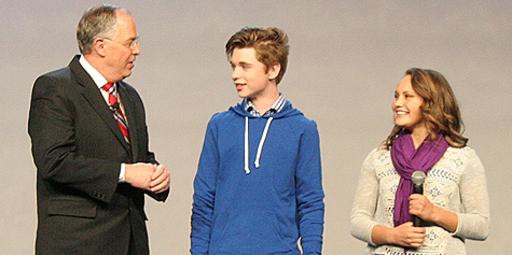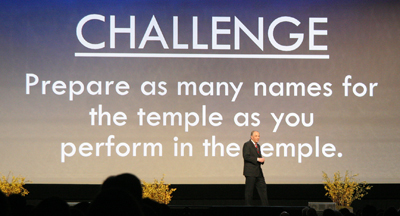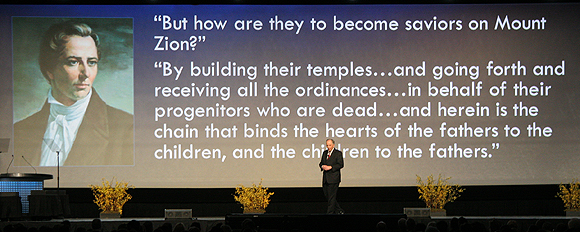Elder Andersen Tells Youth to Help Find Cousins in Family Trees
Contributed By By R. Scott Lloyd, Church News staff writer
Watch the full video of Elder Neil A. Andersen's devotional address to youth titled "Find Our Cousins!" given February 8 in conjunction with the RootsTech Family History Conference in Salt Lake City.
Article Highlights
- There are two ways to find one’s deceased cousins who have not received temple ordinances:
- 1. Go to a pedigree chart and find the brothers and sisters of one’s ancestors.
- 2. Use the Church’s newly printed booklet My Family: Stories That Bring Us Together to help others fill in their own family history stories and pedigrees.
“My challenge for you is to prepare as many names for the temple as you perform baptisms in the temple.”
—Elder Neil L. Andersen
Related Links
Read Elder Andersen's entire talk "Find Our Cousins!"
While youth in the Church today have become extremely devoted in visiting temples to be baptized for the dead, “in the months and years ahead you will be just as outstanding in finding and bringing names to the temple with you,” Elder Neil L. Andersen of the Quorum of the Twelve Apostles told a gathering of 4,000 youth February 8 at the Salt Palace Convention Center in Salt Lake City.
It was the closing youth devotional for Family Discovery Day, a component of RootsTech 2014, the largest family history conference in North America.
But while the conference drew attendees from 49 states, this devotional was designed for Latter-day Saint youth. They responded overwhelmingly to this devotional and to a series of sessions held earlier in the day that comprised Family Discovery Day. In addition to the 4,000 registrants, another 1,000 had to be turned away because they could not be accommodated.
“Let me show you what is ahead,” Elder Andersen said.
He asked those who had ever participated in a temple baptism to stand. Virtually everyone in the audience did.
He then asked them to stay standing if they had participated in a temple baptism for an ancestor and, finally, to remain standing if they had submitted more names of ancestors for baptisms than they had personally performed in the temple. Only a smattering remained standing after the last question.
“I believe that in three years almost everyone will be standing,” Elder Andersen said. “I want to challenge each of you to set a personal goal to help prepare as many names for the temple as baptisms you perform in the temple.”
Elder Andersen said there is joy and satisfaction that is understood only through spiritual feelings such as those that come when one helps a deceased person receive temple ordinances.
He said that this past year for the first time, he could see his ancestors in a fan chart online. His seven-generation fan chart was displayed on a large screen.

Elder Neil L. Andersen addresses a devotional congregation for youth during Family Discovery Day at RootsTech 2014. Photo by R. Scott Lloyd.
“If your chart is not as complete as mine, your first responsibility is to fill it in as best you can,” he said. “More information is becoming available each month.
“If your chart is as complete as mine, there is still very important work for you to do. This work goes on and on. It will not be complete even when the Savior returns. When our chart appears complete, we help others find those in their lines, and we find those closely related to those on our family tree. We call it ‘finding our cousins.’”
He gave two ways to find one’s deceased cousins who have not received temple ordinances.
One way is to go to a pedigree chart and find the brothers and sisters of one’s ancestors.
The other way, he said, is to use the Church’s newly printed booklet My Family: Stories That Bring Us Together to help others fill in their own family history stories and pedigrees.

Elder Neil L. Andersen displays his own fan chart and a photo of his great-grandfather Niels Andersen. “Do you think I have the genes to grow a great mustache?” he asks playfully. Photo by R. Scott Lloyd.
“As you do, you will help them bring others to the temple,” Elder Andersen said. “These are your brothers and sisters, but we also like to call them ‘our cousins.’”
He showed a video featuring the family of his daughter Kristen and her husband, Mark Ebert. It showed how the family helped a beloved friend in their ward to find her own family history and take names to the temple.
Elder Andersen then introduced a new song called “Find Our Cousins,” written by Ross Boothe for the occasion and performed by two young soloists, Tia Thompson and Micah Rindlisbacher.
With the help of his grandson Clayton Hadlock, Elder Andersen demonstrated how to find cousins in one’s ancestral pedigree by using an online tool called puzzilla.org that allows a user to see hundreds of an individual’s descendants from an aerial view with compact symbols revealing patterns of incomplete research.

Elder Neil L. Andersen thanks vocalists Micah Rindlisbacher and Tia Thompson after their performance of “Find Our Cousins,” composed expressly for the youth devotional of Family Discovery Day at RootsTech 2014. Photo by R. Scott Lloyd.
Working together on the same computer, each with his own mouse, Elder Andersen and Clayton found an ancestor’s name and a pattern showing their direct line and other lines, which comprise their cousins.
From Puzzilla, they were able to access the Church’s FamilySearch.org, which tells whether or not there have been vicarious temple ordinances performed for an individual. It also helps find documentation, such as birth or christening records that are essential in preparing names for temple work.
“Papi, by clicking on this record, you have found our cousin, and now we can offer her the ordinances of the temple,” Clayton said to his grandfather, Elder Andersen.

Elder Neil L. Andersen gives a challenge to the youth assembled for a devotional during Family Discovery Day, part of RootsTech 2014. Photo by R. Scott Lloyd.
He said, “Papi, even though our family has been in the Church for many generations, there are numerous cousins to be found. I’ll bet it is true for every family.”
“It is true, Clayton,” Elder Andersen replied. “We all have cousins waiting for our work.”
To the assembled youth, he said, “When we see ourselves in perspective of our family, those who came before us and those who came after us, we realize how we are part of a wonderful link that connects us all together. As we search them out and take their names to the temple, we bring to them something they cannot obtain without us. In doing so, we are connected to them, and the Lord through His Spirit confirms to our soul the eternal importance of what we are doing.”

Elder Neil L. Andersen speaks to youth of the obligation to be “saviors on Mount Zion” as a quote from Joseph Smith is projected behind him. Photo by R. Scott Lloyd.
He closed with an apostolic blessing to all within the sound of his voice: “As you seek to contribute to this sacred work, both by finding those needing ordinances and then beginning their work in the temple, your own knowledge and faith in the Savior will increase, and you will receive a more certain witness that life continues beyond the veil. I know that life continues beyond the veil. I know it.”
